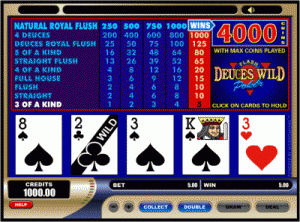The Tough Truth About Multiple-Play Video Poker
Why packing the proper bankroll is critical if you’re going to survive and thrive at this game
By Jerry “Stickman” Stich
The more knowledgeable you are about the game you’re playing, the better prepared you’ll be to enjoy it (and capitalize on opportunities). With multiple-play video poker, this means you’ll need to bring a larger bankroll in order to play as long as you could on a single-play game.
Normal video poker machines are called “single play” because they invite you to play one game at a time. But these certainly aren’t the only types of video poker games. You’ll also encounter games that enable you to play three, five, 10, 50 and even 100 games at a time.
These “multiple-play” games deal the exact same hand to three, five, 10, 50, or 100 hands. The player then decides which cards to save for all the hands dealt. The strategy for playing a multi-play game is exactly the same as when playing a single-play game.
If you’re dealt a good initial hand, you can make some nice money. However, over half of all hands in video poker end up being losers. Because of this, the variance (amount of bankroll swings, both plus and minus) for multiple-play games is higher than for single-play games. You need a bigger bankroll to play multi-play games of the same denomination.
In a single-play game, variance is higher when more money is paid out on high paying hands. For example, 9/6 Jacks or Better (where a full house is paid at 9-for-1 and a flush is paid at 6-for-1) has only one very high paying hand: the royal flush. The variance on this game is 19.5. Bonus Poker is different than Jacks or Better because it pays a bonus for four aces (80-for-1 instead of 25-for-1) and four 2s, 3s or 4s (40-for-1).
Payoffs for a full house and a flush are reduced to make up for the higher payoffs on the quads. The variance for Bonus Poker is 20.9—a seven percent increase over Jacks or Better. Double Bonus Poker increases the bonus on four aces to 160-for-1; the bonus on four 2s, 3s, or 4s to 80-for-1; and the bonus on 5s through kings to 50-for-1. Two pair payoff is reduced to 1-for-1 to compensate for the increased quad payoffs. By concentrating on fewer, larger payoffs and reducing the more frequent, lower payoffs, variance on Double Bonus Poker soars to nearly 28.3. That’s a whopping 48 percent increase from Jacks or Better.
In multiple-play games, variance increases as the number of plays increase—not because more money in concentrated in fewer high paying hands, but because the strength of each multiple-play game is determined by the initial five cards that are dealt. If it’s a strong hand, each play will have a strong hand. If it’s a weak hand, each play will be weak. For example, if the initial hand contains three aces, the minimum that each play will return is 3-for-1.
If, however, the initial hand contains nothing and needs to be completely discarded, the chances for a positive outcome for this hand are small.
Now let’s look at some specific games, plays and variances.
As stated above, variance for single-play Jacks or Better is 19.5. A 3-play Jacks or Better game has a variance of 23.4—a 20 percent increase. In the 5-play version of Jacks or Better, the variance now becomes 27.3—40 percent greater than single-play. 50-play Jacks or Better has a variance of 115.8, and the 100-play version has a variance of 214. That’s 997 percent greater than the single-play version of the game! We’re talking about a huge variance for a game that initially has a relatively low variance.
What about a game with a higher single-play variance? Double Bonus Poker has a single-play variance of 28.3—48 percent higher than single-play Jacks or Better. The 3-play version of Double Bonus Poker has a variance of 35.0—a 24 percent increase from the single-play version. 5-play Double Bonus Poker has a variance of 41.8 (48 percent higher). The variance on 10-play is 58.5 (108 percent higher). 50-play variance is 194.4 (588 percent higher). And 100-play variance is 364—an incredible 1,188 percent higher!
Those are some pretty big numbers. But what do they mean to the average video poker player?
First off, let me emphasize that the more knowledgeable you are about the game you’re playing, the better prepared you’ll be to enjoy it (and capitalize on opportunities). With multiple-play video poker, this means you’ll need to bring a larger bankroll in order to play as long as you could on a single-play game. Even on the relatively low variance Jacks or Better, the variance of the 100-play game is 10 times that of the single play game. This means that even if you were to play a lower denomination multiple-play version of the game, you’d still probably need a larger bankroll.
For example, if you normally play single-play Jacks or Better at the $1 level, it may seem logical that you could play 100-play Jacks or Better at the 1¢ level. After all, you wager one dollar on each hand in either game. But, by looking at the increased variance for 100-play (10 times that of single-play), it’s easy to see that the same bankroll won’t be sufficient.
Keep in mind that variance can be good or bad. When riding the wave of positive variance, life is very good indeed. However, when wallowing in the pit of negative variance, it feels as if Lady Luck has abandoned you and the game is unbeatable. We encounter these hot and cold streaks with all casino games, from blackjack to the slots. One of the golden rules of gambling is that you must always possess a bankroll that is adequate for the game you will be playing—and this is especially true if your plans include multiple-play video poker.
The Tough Truth About Multiple-Play Video Poker.



